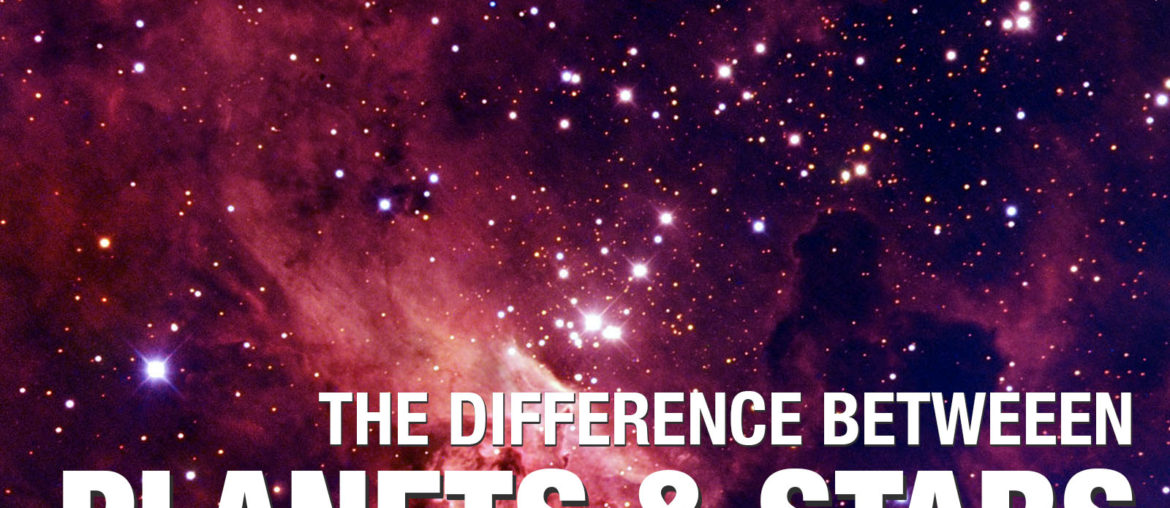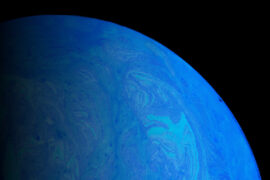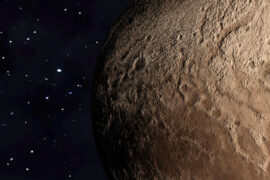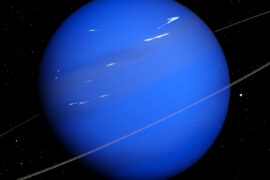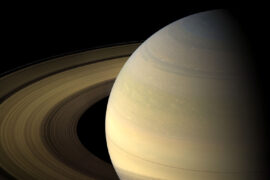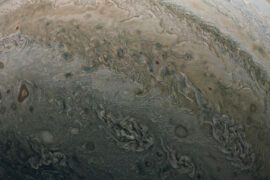Understanding our universe can be a daunting task sometimes. There’s so much stuff out there between planets, asteroids, stars, black holes, nebulas, pulsars, and other objects that things can get confusing. We need some way to classify all these objects and recognize them easily. It is, for this reason, we are going to take a look at the main differences between a planet and a star. Each one has a very clear definition that will help you not get them confused ever again.
The five main differences between planets and stars are:
- Planets orbit around a star. Stars do not orbit planets.
- Planets are made of rock, ice, gas or water. Stars are made of plasma.
- Stars emit their own light. Planets don’t.
- Planets are always colder than the stars in their system.
- Inside a star, nuclear fusion is constantly happening. This doesn’t happen on a planet.
1. Planets orbit around a star. Stars do not orbit planets.

The very definition of a planet states that for a planet to be classified as such, it must be found orbiting a star just like Earth orbits around the Sun.
Stars have a greater mass than planets. The gravity of all this mass is what “locks” planets into their orbits and makes them go around it when they are created. While the opposite could theoretically happen (have a star orbit around a planet), the laws of physics make it almost impossible and such a system has never been found.
Some definitions state that stars are stationary while planets orbit around them. This is incorrect because stars are also moving around the center of their galaxies. It also fails to account for multi-star systems. These have more than one star and they are sometimes circling around each other or one might even be orbiting the other. Remember that scene in Star Wars in Tatooine where Luke is looking up at the sky and there are two suns setting? that would be a multi-star system.
2. Planets are made of rock, ice, gas or water. Stars are made of plasma.
Plasma is the fourth fundamental state of matter after solid liquid and gas. Plasma can be hard to explain as it is not easy to visualize it and the definition can be confusing. Think of it like really hot gas that starts conducting electricity. A lightning bolt is an example of plasma.
The nuclear reactions happening in the core of stars make it so hot that most of it becomes plasma. On the other hand, planets can be made of many different elements. For example, Mars is made of rock and ice while Jupiter and Saturn are mostly made of gas and only a small rocky core.
While plasma can be found on some planets, especially on very hot ones, it is not their main component.
3. Stars emit their own light. Planets don’t.
Stars are bright and it is possible for them to emit light because of the nuclear reaction happening in them. Planets are made of much colder elements that for the most part do not generate light. The reason why we can see planets from Earth is the same reason why we can see the Moon. They are reflecting the light from the Sun. In the case of distant planets, they also reflect the light from their own stars.
If you want to get very specific, there are some exceptions to this rule. Some planets do generate small amounts of light or radiation, but it is usually too weak to be perceived at a long distance. For example, Jupiter does generate some heat emissions that can be detected with infrared equipment, but it is invisible to the human eye.
Speaking about temperature…
4. Planets are always colder than the stars in their system.
The temperature of stars can vary wildly depending on their types. Red dwarf stars, the less hot stars start at 3,500 Kelvin. At the top end, blue supergiants can reach 40,000 Kelvin. Our own sun is somewhere in the low end at 5,800 Kelvin. One thing remains constant, and that is the planets in a stellar system always have a lower temperature than their stars as they don’t have the massive amounts of thermonuclear reactions occurring in their cores that stars do.
At this point, it is important to emphasize the part about planets only being colder than the stars in their system. It is actually possible (although unlikely) for a planet to be hotter than other stars as long as the star it orbits around is even hotter. In 2017 astronomers discovered a planet named Kelt-9b, a gas planet with a hydrogen atmosphere that is so close to a blue supergiant that the gas in it reacts to the star’s temperature making it as hot as 4,000 Kelvin which is hotter than some smaller stars.
5. Inside a star, nuclear fusion is constantly happening. This doesn’t happen on a planet.
Stars are mostly made of two elements: Hydrogen and Helium. Various other gases are found in very small proportions but those are the main ones. In the star’s core, the high temperatures create an effect called thermonuclear fusion that turns the hydrogen into helium, releasing the energy that is sent into the universe in the form of heat and light.
We don’t know a lot about planetary cores as you would need to drill into the planet to study them, but we do know they can be solid, liquid, or a combination of both. Planet cores don’t have many gases and therefore don’t have the type of chemical reactions that would happen in a star.
Definition of a Planet
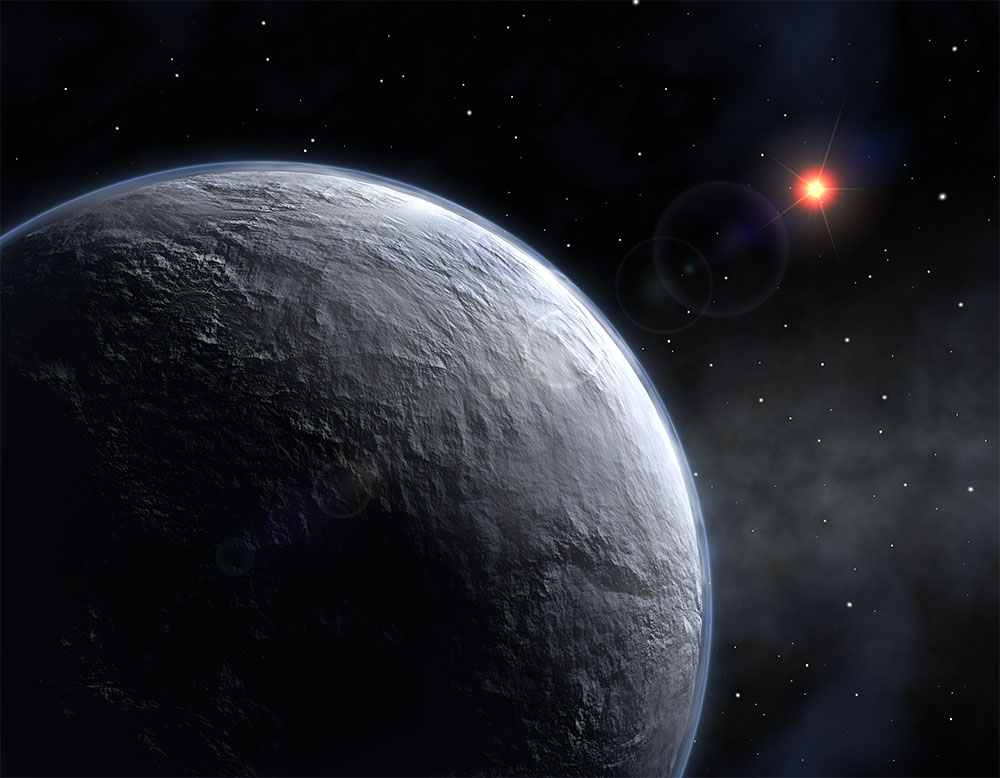
The International Astronomical Union reworked the definition of a planet in 2006 in order to make it more precise as more and more objects were being found in the Solar System that could loosely be classified under the “planet” umbrella without being really relevant objects. A controversy arose during this time as Pluto, which used to be classified as a planet for the longest time was demoted to the dwarf planet classification and stripped of its planet status.
Under this new definition, in order for an object to be classified as a planet it needs to meet the three following requirements:
1) A planet must be an object orbiting around the Sun
2) A planet has enough mass to reach hydrostatic equilibrium. This basically means its own gravity will “shape” it into an almost spherical shape.
3) A planet must have cleared its orbit of other objects. This means no other big objects are found in its orbit other than its own satellites.
It is that last point that took away Pluto’s status as a planet as there are other objects in its “neighborhood”, specifically in an area named the Kuiper belt.
Definition of a star
A star is defined as a luminous object that is going through the process of nuclear fusion and is shaped by its own gravity into an (almost) spherical shape.
The definition of a star can seem confusing as stars go through various stages during their lifetimes. The definition above applies to what is called main-sequence stars, which are stars going through their main fusion stages. When a star is forming or after it dies, it receives a different classification even though some of those might also contain star in their name.
After stars die, they can turn into black dwarfs, neutron stars, or black holes, depending on the size and type of the star.
Table of differences between a planet and a star
With that information and those definitions in mind, we can make a handy table detailing all of the things that make planets different from stars.
Reactions – Are undergoing nuclear fusion – No relevant energy reactions.
Composition – Mostly made of hydrogen and helium – Can be made of rock, ice, gas, water, metals, etc.
Orbit – Don’t orbit around planets – Must be orbiting a star
Luminosity – Emit light – Do not emit light of their own
Temperature – Are the hottest objects in their system – Always colder than their local star
| Stars | Planets | |
| Reactions | Are undergoing nuclear fusion | No relevant energy reactions |
| Composition | Mostly made of hydrogen and helium | Can be made of rock, ice, gas, water, metals, etc. |
| Orbit | Don’t orbit around planets | Must be orbiting a star |
| Luminosity | Emit light | Do not emit light of their own |
| Temperature | Are the hottest objects in their system | Always colder than their local star |
Here’s the same table in pretty image format:
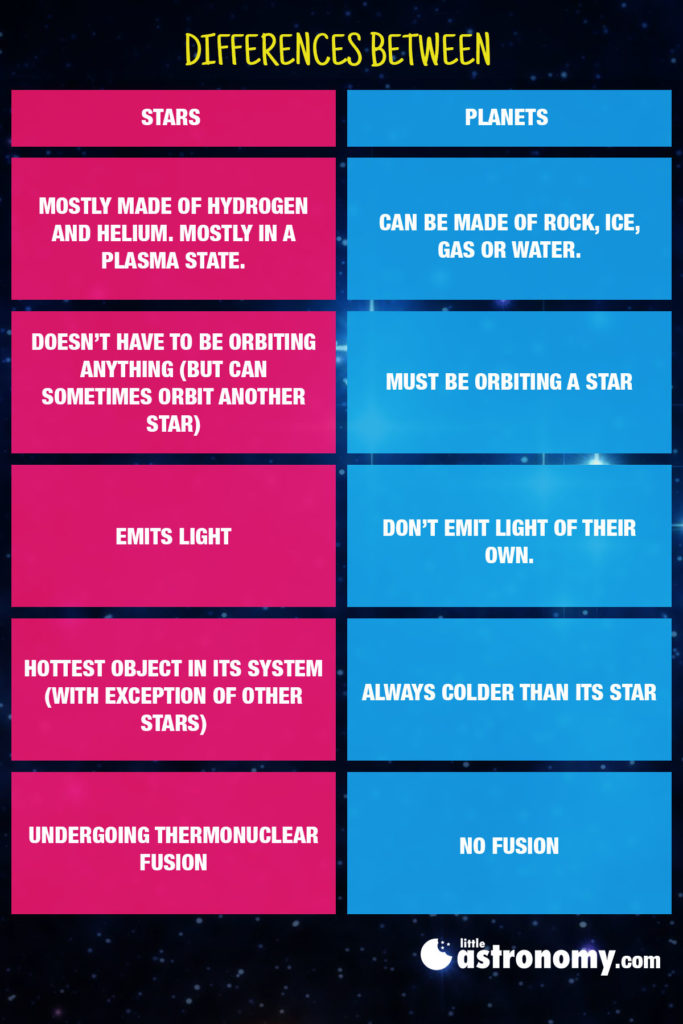
How are planets and stars similar to each other
It might also be worth defining the things that are similar between both types of objects.
- Held together by gravity. Their own gravity is what allows for stars and planets to be “held together” and keep their shape
- Spherical shape. Both planets and stars have spherical shapes

